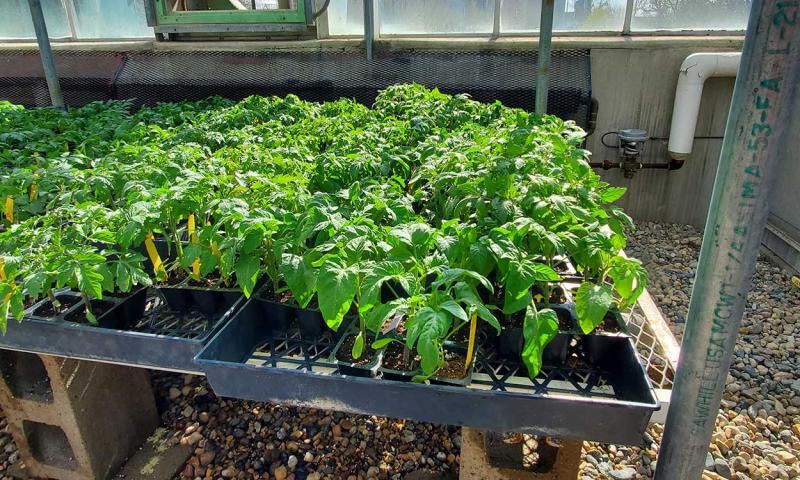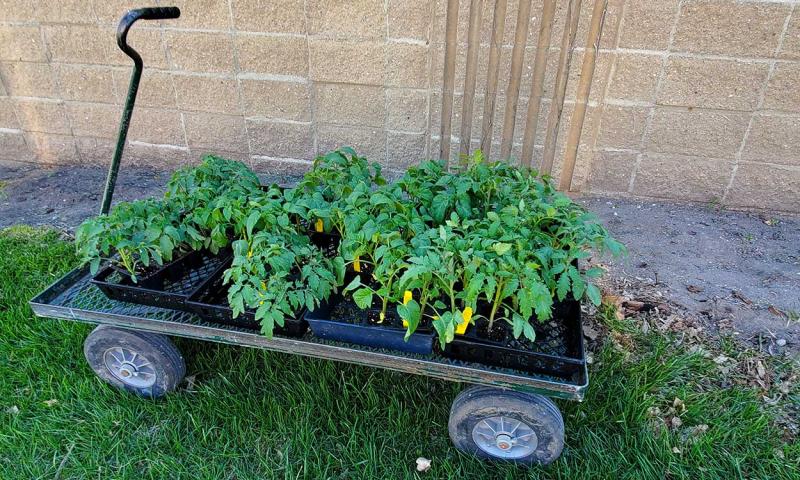Written by Geoffrey Njue, former SDSU Extension Specialty Crops Field Specialist. Revised by Kristine Lang, SDSU Assistant Professor and Consumer Horticulture Extension Specialist, and Cindy Schnabel, SDSU Extension Horticulture Assistant and Master Gardener.
The birds are back singing, the sun is staying up longer, and the temperatures are warming. Gardeners are eager to get seedlings transplanted into the garden. However, if transplants are planted directly in the garden before they are adjusted to the sun, wind, rain and cool outdoor temperatures they may not survive the shock. To avoid transplant shock, it is important to harden transplants properly.
Hardening Defined

Hardening (sometimes called “hardening off”) means gradually getting plants acclimated to outdoor conditions. When plants are taken from their ideal growing conditions and placed into outdoor gardens and containers, they have no protection against the wind, potential subfreezing temperatures, direct sun and fluctuating moisture (Figure 1). The transplants should slowly be exposed to the outdoor conditions so that they can thrive in this environment.
Hardening transplants reduces the plant growth rate and is achieved primarily by reducing the rate of watering and/or lowering the air temperature. This process sets in a motion a variety of physiological processes, including the thickening of the leaf’s protective surface, known as the cuticle. This cuticle thickening aids in preventing plant water loss through transpiration during hot, windy and sunny days. The hardening process allows for an accumulation of carbohydrates within the plant tissues, which provides much-needed reserves for new root growth after transplanting. Plants that have been properly hardened off will also have a decreased percentage of freezable water within the tissues, resulting in greater cold tolerance for early-season crops.
Hardening Timeline

The process of hardening transplants should be carried out over seven to 14 days. You should look up the frost-free date your location in South Dakota to set the date you plan to plant your garden. You can safely plant many cool-season vegetables and several cool-season annual flowers ahead of the frost-free date, but for warm-season vegetables and most annual flowers, you’ll want to stick with planting after the frost-free date for your region.
Whether you have been growing your own transplants, or purchased plants from a garden center, start to harden transplants at least one week prior to planting. You should select a protected location outdoors for hardening your plants. An ideal location is a dappled, shady area out of the wind that is protected in the event of a downpour of rain.
The first day of hardening, you should set your transplants outdoors in the protected location for three-or-four hours when temperatures are warmest. The plants should be brought back indoors after the initial outdoor exposure. If you have large quantities of seedlings to harden, you might consider keeping your plants on rolling wagons or carts for easy transport (Figure 2).
Increase the amount of time you place the plants outside each day, a few more hours each time. For full-sun annuals, gradually increase the exposure to sunlight in the same way you increase the amount of outdoor exposure each day.
Always remember to bring your plants indoors each evening and keep the plants inside if daytime temperatures are projected to be below 45 degrees Fahrenheit, or if there is the threat of strong winds or rains. Transplants should not be stored in unlit garages for prolonged periods, as they may start to stretch or yellow from lack of sunlight. By the last one-to-two days of the hardening process, plants should remain outdoors for 24 hours if nighttime temperatures look favorable.
Watering and Fertilizing
Throughout the process of hardening, you should reduce the frequency of watering without allowing the seedlings to wilt. If plants appear healthy, you should avoid fertilizing during hardening; however, if plants appear deficient in a nutrient, an appropriate dose of fertilizer should be used.
Transplanting Into Your Garden
When the transplants are sufficiently hardened after one to two weeks, they are ready for planting in your garden or containers. Ensure that the weather forecast includes favorable temperatures for your cool or warm-season crops. If there is a frost advisory in the forecast, it is better to wait a few more days to plant than suffer the loss of your plants.
Choose a cloudy day to plant your garden to avoid undo stress on the plants. You should plant early in the morning or evening to avoid planting during the hottest part of the day. Make sure plants are watered thoroughly after planting, and you may also use a dilute starter fertilizer solution. You might need to protect the plants in the event of high winds and extreme cold temperatures even though they are hardened. Water the plants in the morning every day until the roots are well-established in the garden soil. After establishment, you can decrease the frequency of watering depending on plant growth and weather conditions.
Hardening plants is an important step that gardeners should not skip. It is an easy process that allows your plants to grow better once they are placed out in your garden or in a favorite container. Take the time to harden your plants properly and reap the benefits of sturdy, well-established plants throughout the gardening season!


